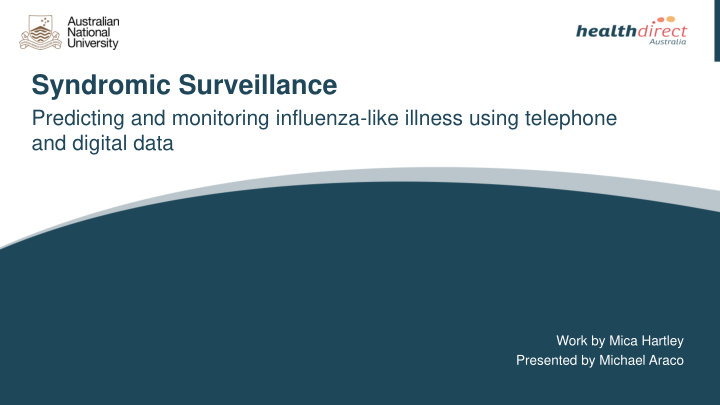



Syndromic Surveillance Predicting and monitoring influenza-like illness using telephone and digital data Work by Mica Hartley Presented by Michael Araco
Outline • Influenza – a healthcare problem • How can telephone and digital data help? • Methods • Results • Conclusions 2
What is the problem? Influenza and influenza related illness is costly • Over 18,000 1 hospitalisations each year • 310,000 GP visits 1 • 4,000 deaths • $115 million in annual healthcare expenditure 1 1. Newall AT, Scuffham PA. Influenza-related disease: the cost to the Australian healthcare system. Vaccine. 2008 Dec 9;26(52):6818-23. 3 2. NCIRS, AIHW. Influenza and Pneumonia. CDI. Supplement - 2008 June; Vol 32: S18-S20.
What is the problem? Influenza is a seasonal illness* In a temperate climate: • Peak in the number of cases over winter (anytime between July and September) • Low activity during summer 4 *(in most parts of Australia, excluding NT)
What is the problem? 5
Telephone and digital data 700,000 calls/year 500,000 visits/year 6
What is syndromic surveillance? Report on syndromes not diagnosed disease • Influenza like illness (ILI) Using data from Healthdirect Australia • healthdirect helpline • Symptom Checker Then we can report these data • For public health action Research Question : Does telephone and digital data correlate well with ED, GP, lab and community data sources? Can it predict activity in EDs, GP clinics or labs? 7
Methods How can we show that telephone and online data reflects trends in the community? 8
Results • Best correlation with emergency departments (range in yearly correlations between 0.92 – 0.99) • The best correlation mostly in 2009, but also 2012, 2014 and 2015. • The worst occurred in 2010 and 2013. 9
Results Does increased flu activity for the telephone helpline occur at the same time as increased flu activity for the other data sources? Data Source Timing NSW Emergency Department same time WA Emergency Department same time GP surveillance Same time FluTracker Same time NSW Laboratory Telephone 1 week in advance Other data sources also correlated well Australia Laboratory Telephone 1 week in advance with both the telephone and online symptom checker (range in yearly 10 correlations between 0.58-0.99)
Information for the public Here’s how to read our flu risk meter: • Minimal – less than 6 in 100 calls (<6%) • Low – 6 to 8 in every 100 calls (6-8%) • Moderate – 8-10 in every 100 calls (8-10%) • High – 10 to 12 in every 100 calls (10-12%) • Intense- greater than 12 in every 100 calls (> 12%) Both the flu risk meter (above) and the graph (left) show the percentage (%) of flu-related calls. 11 healthdirect.gov.au/flu-trends
Information for experts Create a dashboard accessible to stakeholders • Report to National Influenza Surveillance Committee • Create information for public 12 health action
Conclusions • Can be used for surveillance of influenza-like illness • Could predict activity one week in advance in laboratories • Publishing results both on the website and to a dashboard • Started with influenza – like illness, but extendable to other syndromes: eg gastroenteritis, adverse reaction to vaccine, suicidal ideation. 13
Thanks! Thanks to Mica Hartley, Janice Biggs, Kathryn Glass, Carlo Leonessa, Andrew Cole and all the staff at Healthdirect Australia Work by Mica Hartley Presented by Michael Araco
Recommend
More recommend